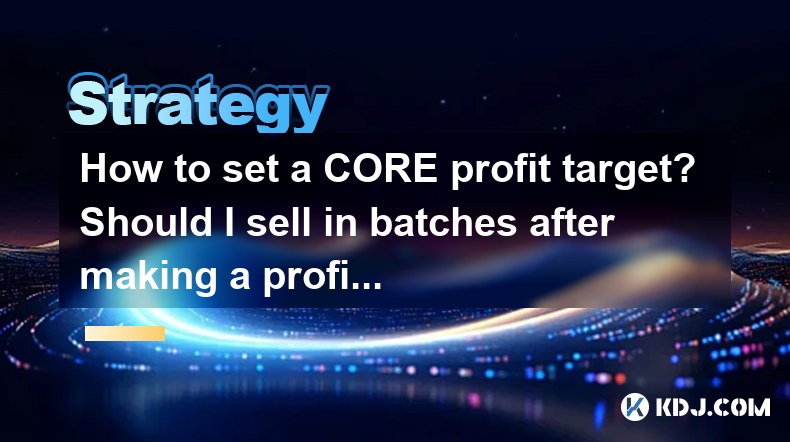-
 bitcoin
bitcoin $122025.899241 USD
-2.12% -
 ethereum
ethereum $4488.068729 USD
-4.11% -
 bnb
bnb $1315.348019 USD
8.65% -
 tether
tether $1.000457 USD
0.03% -
 xrp
xrp $2.875326 USD
-3.69% -
 solana
solana $222.043604 USD
-4.07% -
 usd-coin
usd-coin $0.999682 USD
0.00% -
 dogecoin
dogecoin $0.249887 USD
-5.62% -
 tron
tron $0.337379 USD
-2.59% -
 cardano
cardano $0.827763 USD
-5.06% -
 hyperliquid
hyperliquid $45.774531 USD
-2.43% -
 chainlink
chainlink $22.079309 USD
-5.87% -
 ethena-usde
ethena-usde $1.000156 USD
0.02% -
 sui
sui $3.482566 USD
-3.57% -
 stellar
stellar $0.386982 USD
-4.92%
How to set a CORE profit target? Should I sell in batches after making a profit?
Set a profit target for CORE by analyzing market trends and consider batch selling to manage risk and lock in gains gradually.
May 07, 2025 at 11:01 am

Introduction to Setting a CORE Profit Target
Setting a profit target for your CORE holdings is a crucial aspect of managing your cryptocurrency investments. Profit targets help you to lock in gains and manage risk effectively. In this article, we will explore how to set a profit target for CORE and discuss whether selling in batches after making a profit is a viable strategy.
Understanding CORE and Its Market Behavior
CORE, like any other cryptocurrency, experiences fluctuations in its market price. Understanding the market behavior of CORE is essential before setting a profit target. You should consider factors such as historical price trends, market sentiment, and upcoming developments that could impact the price. Analyzing these elements can provide you with a clearer picture of when to set your profit target.
Steps to Set a CORE Profit Target
Setting a profit target involves a few key steps. Here’s how you can go about it:
- Determine Your Investment Goals: Start by defining what you aim to achieve with your CORE investment. Are you looking for short-term gains or long-term growth? Your goals will influence the profit target you set.
- Analyze Market Trends: Use technical analysis tools to study the price charts of CORE. Look for patterns and indicators that could signal potential price movements. Tools like moving averages, RSI, and MACD can be particularly useful.
- Set a Realistic Target: Based on your analysis, set a profit target that is achievable. For instance, if CORE is currently trading at $10 and you believe it can reach $15 based on your analysis, you might set your profit target at $15.
- Consider Risk Management: Always factor in the risk of the market moving against your expectations. Setting stop-loss orders can help you limit potential losses if the price drops below a certain level.
Should You Sell in Batches After Making a Profit?
Selling in batches, or dollar-cost averaging out, is a strategy where you sell portions of your holdings at different price points. This approach can help you to:
- Reduce the Impact of Market Volatility: By selling in batches, you spread out the risk of selling all your holdings at a single price point. If the market dips after your first sale, you still have other portions to sell at potentially higher prices.
- Lock in Profits Gradually: Selling in batches allows you to lock in profits at various levels, which can be particularly beneficial in a volatile market like cryptocurrencies.
- Maintain Flexibility: Holding onto some of your CORE allows you to remain invested and potentially benefit from further price increases.
How to Implement Batch Selling
Implementing a batch selling strategy involves careful planning. Here’s how you can do it:
- Determine Your Selling Intervals: Decide at what price points you want to sell your CORE. For example, you might decide to sell 25% of your holdings at $15, another 25% at $20, and so on.
- Set Up Sell Orders: Use your exchange’s trading platform to set up limit sell orders at your chosen price points. This ensures that your sales are executed automatically when the price reaches your target.
- Monitor and Adjust: Keep an eye on the market and be ready to adjust your selling strategy if necessary. If the market conditions change significantly, you might need to revise your selling intervals.
Using Trading Platforms for Setting Profit Targets and Batch Selling
Most cryptocurrency exchanges offer tools that can help you set profit targets and execute batch selling strategies. Here’s how you can use these tools:
- Setting Profit Targets: On platforms like Binance or Coinbase, you can set limit orders to sell your CORE at your target price. Navigate to the trading section, select CORE, and enter the price at which you want to sell.
- Batch Selling: To implement batch selling, you will need to set multiple limit orders at different price points. On most exchanges, you can do this by repeating the process of setting a limit order for different portions of your holdings.
Considerations for Setting Profit Targets and Batch Selling
When setting profit targets and considering batch selling, keep the following in mind:
- Market Volatility: Cryptocurrency markets can be highly volatile. Be prepared for sudden price swings and have a plan in place to manage them.
- Tax Implications: Selling your CORE holdings can have tax consequences. Depending on your jurisdiction, you may need to pay capital gains tax on your profits. Consider consulting a tax advisor to understand your obligations.
- Emotional Discipline: It can be challenging to stick to a pre-determined strategy, especially during periods of high market volatility. Maintaining emotional discipline and sticking to your plan is crucial for long-term success.
Frequently Asked Questions
Q: Can I set a profit target for CORE on all cryptocurrency exchanges?A: Most major cryptocurrency exchanges allow you to set profit targets using limit orders. However, the specific features and user interfaces can vary between exchanges. Always check the trading platform's documentation to understand how to set up limit orders.
Q: How do I know if my profit target for CORE is too aggressive or too conservative?A: Determining whether your profit target is aggressive or conservative depends on your analysis of market trends and your risk tolerance. If your target is significantly higher than recent highs, it may be considered aggressive. Conversely, if it's close to the current price, it might be seen as conservative. Regularly reviewing your targets and adjusting them based on new market data can help you find the right balance.
Q: Is it better to sell all my CORE at once or in batches?A: Whether to sell all at once or in batches depends on your investment strategy and market conditions. Selling in batches can help mitigate risk and lock in profits at different price points, but it requires more active management. Selling all at once can be simpler but carries the risk of missing out on potential future gains.
Q: Can I automate the batch selling of CORE?A: Some advanced trading platforms offer features like trailing stop orders or automated trading bots that can help you execute a batch selling strategy. However, setting up such automation often requires a good understanding of the platform's tools and may involve additional fees.
Disclaimer:info@kdj.com
The information provided is not trading advice. kdj.com does not assume any responsibility for any investments made based on the information provided in this article. Cryptocurrencies are highly volatile and it is highly recommended that you invest with caution after thorough research!
If you believe that the content used on this website infringes your copyright, please contact us immediately (info@kdj.com) and we will delete it promptly.
- BlockDAG, DOGE, HYPE Sponsorship: Crypto Trends Shaping 2025
- 2025-10-01 00:25:13
- Deutsche Börse and Circle: A StableCoin Adoption Powerhouse in Europe
- 2025-10-01 00:25:13
- BlockDAG's Presale Buzz: Is It the Crypto to Watch in October 2025?
- 2025-10-01 00:30:13
- Bitcoin, Crypto, and IQ: When Genius Meets Digital Gold?
- 2025-10-01 00:30:13
- Stablecoins, American Innovation, and Wallet Tokens: The Next Frontier
- 2025-10-01 00:35:12
- NBU, Coins, and Crypto in Ukraine: A New Yorker's Take
- 2025-10-01 00:45:14
Related knowledge

Practical parameter settings for a Bitcoin multi-timeframe moving average system
Sep 18,2025 at 10:54pm
Optimizing Timeframe Combinations for Bitcoin Trading1. Selecting appropriate timeframes is crucial when building a multi-timeframe moving average sys...

How can I filter out false breakouts in Dogecoin high-frequency trading?
Sep 22,2025 at 01:00am
Understanding False Breakouts in Dogecoin Trading1. A false breakout occurs when Dogecoin's price appears to move beyond a defined support or resistan...

Techniques for identifying tops and bottoms in the Bitcoin on-chain NVT model
Sep 20,2025 at 07:54pm
Understanding the NVT Model in Bitcoin Analysis1. The Network Value to Transactions (NVT) ratio is often described as the 'P/E ratio' of the cryptocur...

What does the surge in open interest in Bitcoincoin futures mean?
Sep 20,2025 at 11:18pm
Understanding the Surge in Dogecoin Futures Open Interest1. A surge in open interest within Dogecoin futures indicates a growing number of active cont...

How can I use the Ethereum USDT premium to gauge market sentiment?
Sep 18,2025 at 11:55pm
Understanding the Ethereum USDT Premium1. The Ethereum USDT premium refers to the price difference between USDT (Tether) traded on Ethereum-based plat...

What should I do if Ethereum staking yields decline?
Sep 20,2025 at 06:18am
Understanding the Causes Behind Declining Ethereum Staking Yields1. The Ethereum network transitioned to a proof-of-stake consensus mechanism with the...

Practical parameter settings for a Bitcoin multi-timeframe moving average system
Sep 18,2025 at 10:54pm
Optimizing Timeframe Combinations for Bitcoin Trading1. Selecting appropriate timeframes is crucial when building a multi-timeframe moving average sys...

How can I filter out false breakouts in Dogecoin high-frequency trading?
Sep 22,2025 at 01:00am
Understanding False Breakouts in Dogecoin Trading1. A false breakout occurs when Dogecoin's price appears to move beyond a defined support or resistan...

Techniques for identifying tops and bottoms in the Bitcoin on-chain NVT model
Sep 20,2025 at 07:54pm
Understanding the NVT Model in Bitcoin Analysis1. The Network Value to Transactions (NVT) ratio is often described as the 'P/E ratio' of the cryptocur...

What does the surge in open interest in Bitcoincoin futures mean?
Sep 20,2025 at 11:18pm
Understanding the Surge in Dogecoin Futures Open Interest1. A surge in open interest within Dogecoin futures indicates a growing number of active cont...

How can I use the Ethereum USDT premium to gauge market sentiment?
Sep 18,2025 at 11:55pm
Understanding the Ethereum USDT Premium1. The Ethereum USDT premium refers to the price difference between USDT (Tether) traded on Ethereum-based plat...

What should I do if Ethereum staking yields decline?
Sep 20,2025 at 06:18am
Understanding the Causes Behind Declining Ethereum Staking Yields1. The Ethereum network transitioned to a proof-of-stake consensus mechanism with the...
See all articles










































































